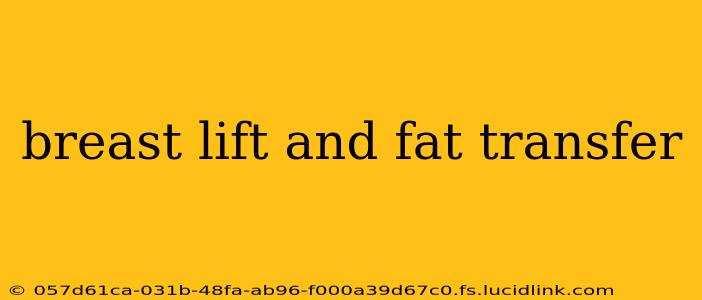A breast lift, also known as a mastopexy, and fat transfer are two distinct procedures often considered together for breast enhancement. While a breast lift primarily addresses sagging breasts by repositioning breast tissue and removing excess skin, a fat transfer adds volume to the breasts using the patient's own fat. This combination can create a more youthful, fuller, and natural-looking breast shape. This comprehensive guide will explore the intricacies of both procedures and answer frequently asked questions.
What is a Breast Lift?
A breast lift is a surgical procedure designed to improve breast shape and firmness. It addresses sagging breasts caused by factors like aging, weight loss, pregnancy, and genetics. During the procedure, the surgeon removes excess skin and repositioning the breast tissue, resulting in a higher, firmer, and more youthful breast appearance. The incision techniques vary depending on the degree of lift needed, but commonly involve incisions around the areola, vertically down the breast, or in an anchor shape.
What is a Fat Transfer to the Breasts?
A fat transfer, also known as autologous fat grafting, involves harvesting fat from another area of the body (often the abdomen, thighs, or hips) using liposuction. This harvested fat is then processed and injected into the breasts to increase volume and improve overall shape. The fat transfer can enhance the results of a breast lift, adding fullness and improving the overall aesthetic outcome. It's a natural alternative to breast implants.
How is a Breast Lift and Fat Transfer Combined?
Often, a breast lift and fat transfer are performed simultaneously. This combination offers several advantages:
- Improved Breast Shape and Volume: The lift addresses sagging, while the fat transfer enhances volume and creates a more natural-looking contour.
- Less Scarring (potentially): Depending on the amount of lift needed, a fat transfer may allow for less extensive incisions compared to a breast lift alone.
- Natural Results: Using the patient's own fat cells provides a more natural and harmonious result than using breast implants.
What are the Risks and Complications of a Combined Breast Lift and Fat Transfer?
As with any surgical procedure, there are potential risks and complications associated with a breast lift and fat transfer. These can include:
- Infection: As with any surgery, there's a risk of infection at the surgical sites.
- Bleeding: Excessive bleeding can occur, requiring further intervention.
- Nerve Damage: Nerve damage can lead to numbness or altered sensation in the breasts.
- Fat Necrosis: Some of the transferred fat may not survive, leading to irregularities in the breast shape.
- Asymmetry: It's possible that the breasts may not be perfectly symmetrical after the procedure.
- Poor Healing: Delayed or poor wound healing can lead to complications.
What is the Recovery Process Like After a Breast Lift and Fat Transfer?
Recovery time varies depending on the individual and the extent of the procedure. Expect:
- Pain and Discomfort: Pain medication is usually prescribed to manage discomfort.
- Swelling and Bruising: Significant swelling and bruising are common and typically improve over several weeks.
- Drainage Tubes: Drainage tubes may be placed temporarily to remove excess fluid.
- Compression Garment: A compression garment will need to be worn for several weeks to support the breasts and minimize swelling.
- Gradual Improvement: The final results are typically not visible for several months as swelling subsides and the transferred fat integrates.
Is a Breast Lift and Fat Transfer Right for Me?
Whether a combined breast lift and fat transfer is the right choice depends on several factors including your individual anatomy, desired results, and overall health. A thorough consultation with a qualified plastic surgeon is essential to determine suitability and discuss realistic expectations.
How Much Does a Breast Lift and Fat Transfer Cost?
The cost of a combined breast lift and fat transfer varies widely based on several factors such as geographic location, surgeon's experience, and the complexity of the procedure. A consultation is necessary to obtain a personalized cost estimate.
How Long Do the Results of a Breast Lift and Fat Transfer Last?
The longevity of results from a breast lift and fat transfer depends on factors like age, weight fluctuations, and lifestyle choices. While the breast lift results are generally long-lasting, transferred fat may gradually be reabsorbed over time, necessitating possible touch-up procedures.
What are the Alternatives to a Breast Lift and Fat Transfer?
Alternatives to a combined breast lift and fat transfer include:
- Breast Augmentation with Implants: This procedure involves placing breast implants to increase breast size.
- Breast Lift Alone: This addresses sagging but doesn't increase breast volume.
- Non-surgical Breast Enhancement: This may include creams, serums, or massage techniques, but these methods typically offer minimal to no noticeable changes.
This article provides general information and should not be considered medical advice. Always consult a qualified plastic surgeon for personalized advice and assessment.
